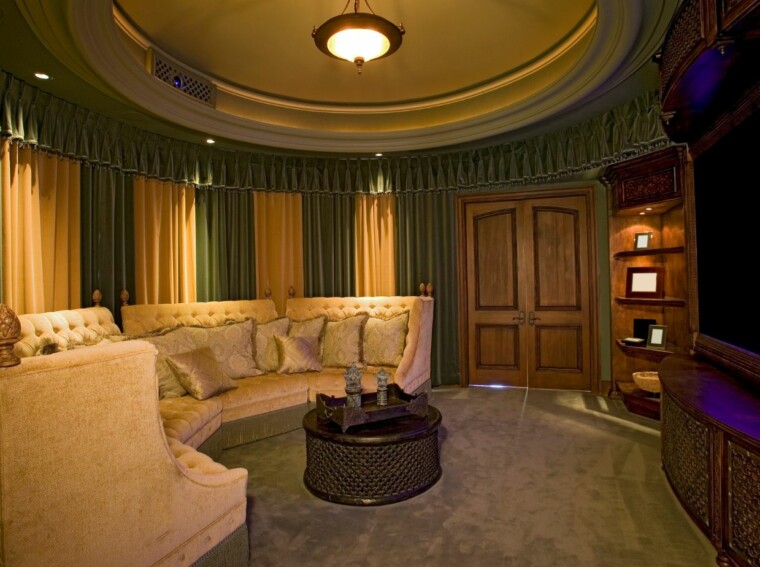If you are building a new home, doing some remodeling, or perhaps just ready for something new, you might be wondering if you can build a home theater room. If you have construction capabilities, the answer is a resounding yes. Creating a dedicated home cinema is actually not that complicated, whether you are constructing an entirely new room or converting an existing space. The most important part of building a home theater is planning. To avoid running into problems along the way, make sure you have planned out every measurement and step in the process before you begin. While you may need some extra consulting depending on the specifics of your desired layout, here are all the basics of constructing the perfect home theater:
The Layout Starts With You
Little known fact — when you design the initial layout of the theater room, you might be surprised to know that the most important part is you. A home theater should be designed differently from a commercial theater. You’re not trying to fit in the maximum amount of seating for the space; you’re trying to create the ultimate theater experience, especially for the central one or two viewers.
Rather than cramming in seating and figuring out the screen and speaker placement later, you need to start with the location of “the King’s chair” or the optimal viewing point. Typically this is located in the middle of the room, slightly back from the center, but the ideal placement depends on the specific room layout. Once you know where you want that to be, you can work out the ideal projector screen size, sound system arrangement, lighting, and other seats.

Room Size
If you are constructing a new room, the world is your oyster in terms of dimensions. However, you will want to start with a room that is at least 15 feet wide and 20 feet long. Any smaller can easily start to feel cramped once you have the seating and all the equipment inside. You also want to consider the maximum projector screen size that you can fit in the room. Don’t compromise on screen size too quickly, as it can have a significant impact on theater immersion. Take into consideration the space needed for the sound system, as well as AV racks, walkable aisles, a bar if desired, and décor.
As for height, you want the ceiling to be at least 7 feet high. This is because the screen should be mounted at least 2 feet off the ground for comfortable viewing. The height of the room can easily limit the size of the screen you can fit, so keep that in mind.
Dimension Proportions
The shape and dimensions of the room are extremely important for proper acoustics. Poor dimensions can lead to serious audio problems like difficulty understanding dialogue or muddiness of sound effects.
There isn’t exactly a perfect room shape, but you should aim to keep the width of the room at least 1.6 times the ceiling height and the length at least 2.3 times the ceiling height. Of course, if you’re converting an existing room, just try to pick one that is large enough and follows these ratios the closest. At the very least, you definitely want to pick a room that has a rectangular shape. Never build a home theater out of a cubic room where all the dimensions are the same. This results in terrible acoustics.
You’ll also want to invest in soundproofing and absorption materials to further improve acoustics.

Projector and Screen
When deciding on a projector and screen combo, you should try to get the biggest possible screen that will fit in the dimensions of the room. Don’t forget about the space needed for speakers and lights that you may have to place on the sides or above and below. Before choosing a screen, you probably want to plan out the entire speaker system and placement.
Next up is the aspect ratio. You have two aspect ratio options: 16:9 and 2.35:1. The latter is the standard for cinema, so if you want to watch movies in full immersion, you should go with the wide ratio. The downside to this is you will have black bars on the sides when you stream shows or watch TV. If you go with 16:9, you’ll have the opposite problem. Alternatively, you can opt for a multi-format screen that allows you to mask sections of the screen to display the proper dimensions.
Lighting and Brightness
In terms of lighting, you should design the room so that you have total control over the ambient light in the room. Ideally, this means no windows or windows that can be completely covered. When it comes to projectors and displaying a vibrant image, little to no ambient light is essential.
With ambient light controlled, you can assess luminance. Luminance refers to the light that is reflected off the screen back to the viewer. This measurement is influenced by the lumen output of the projector and the gain of the screen.
Lumen output tells you how much light the projector is producing in the first place. Screen gain tells you how reflective the projector screen is. With a home cinema room, you probably don’t need a screen gain higher than 1.3. Many screens will have information about recommended lumen output values to be paired with. To be sure your projector and screen are fully compatible, you can get a projector and screen package from a home cinema provider like Selby.
You really can’t have a home cinema room without fun lighting fixtures. When investing in lighting, be sure to get lights that have dimming controls, preferably with a remote or app control. It’s important to consider the visibility of the floor when moving around the room in addition to the vibe.

